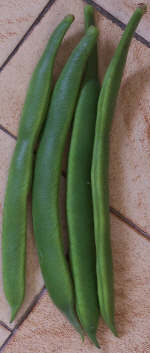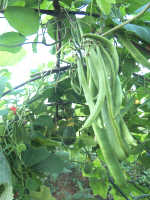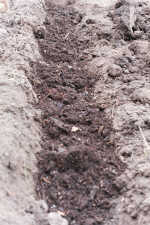|
Tips for Growing Runner Beans
|
MORE ABOUT GROWING POLE BEANS HERE: |
Runner Beans are a Great Home-Grow Crop:-
- They are nutritious, good and healthy to eat
- Have a more distinctive flavour than French beans
- You can eat the fresh pods after cooking, or harvest seeds from older pods to cook as haricot beans
- They are often prolific croppers - with a deep freeze you can grow enough to last many months
- They easily grow in odd spaces amongst flowers, etc...
- Scarlet Runner Beans also carry attractive flowers
- Nowadays flat runner beans are not stocked fresh in small fruit & veg shops, or in tins or frozen packs
- Like other plants of the pea family this crop leaves your soil enriched in nitrogen - damaged soil? check here
AND for American Gardens .
Different Methods For Growing Runner Beans
- Maypole - beans grow up strings fixed to a pole top at one end while the other ends are pegged to the ground around the pole
- a less obtrusive support suited to growing runner beans in flower beds as well as pretty herbacious climbers (e.g. Sweat Peas)
- U.K. growers can get the Maypole support here
- American gardeners can
get bean support combined with seed order
- and try this
elegant Maypole support - both on these links
- Wigwam - involves planting a circle of bean poles that slope so their top ends are tied together over the centre
- a more conspicuous structure to site in flower beds
- but simple to construct in odd corners of the kitchen garden
- Wall - a single row of bean poles often reinforced with netting
- use this support for growing runner beans along a fence or wall
- best supported between stout uprights at the row ends
- erecting permanent uprights at the corners of a square allows you to move the runner bean row around from year to year
- Double Row - pairs of bean poles planted 2 feet apart in a double row, each leaning together and fixed at the top...
- for use on vegetable beds - full details are given below
- dig trench one spit deep in autumn or winter
- line bottom with soaked newspaper
- fill with garden compost and firm down
- for convenience lay a seep hose a few inches below surface and draw soil over to level
- water well and lay a strip of 2 foot wide black polythene mulch
- plant pairs of bean poles about 1.5 feet deep - Pole pairs are tied together at top and connected to a horizontal top pole - End poles are pegged to the ground to prevent leaning
- plant runner beans 6 to 12 inches apart - The plants wind around the poles and hold on to them by tendrils
- a compost trench can be used directly for growing runner beans by this method - ensure ground is firm before planting
- the double row requires space for 2 narrow paths, one along each side see runner bean arch below
- Runner Bean Arch - Involves bending pairs of rustic poles into an archway over a garden path
- Saves space when a path is included under the arch
- beans don't hide in foliage, they hang down and are easier to pick
- soften willow poles in water for a few days before bending them - thinner poles are usually better
- build each side by tying two poles together and sink 18 inches deep - Bend top sections over and tie together over centre - Add horizontal poles at top and sides, and diagonal poles into ground to prevent leaning
- it should be sturdy enough to support (larger) perching birds and the crop when it's windy
- Natural Support - Sweet corn, trees or hedging can sometimes be used
- use slow growing evergreen trees or hedging - Supports that won't compete or need to be trimmed while growing runner beans.
- planting in containers is best for hedge or tree supports - or prepare site with plenty of moisture retentive compost and plant a few feet from a hedge support
- taller Sweet Corn varieties can be used to support Runner Beans - grow beans in a seperate row - coordinate sowing and planting times


| Autumn/Winter: trench filled with garden compost ready for growing runner beans in rows. |

|
Site and Soil Preparation
A firm moisture retentive soil is best for growing runner beans. Dig in plenty of organic matter during autumn or winter. Fill trenches one spit deep with garden compost to plant in rows; add in bucket fulls for maypoles or wigwams.
Soaked newspapers (or leaf mold) layed on the bottom help to retain moisture. Shredded Comfrey leaves can boost flowers and fruit. Gently firm down as you add material.
Don't add Nitrogen rich fertilizer e.g. no manure... Nitrogen fixing bacterial grow in root nodules of beans. Some gardeners have achieved very good results from soil inoculating - my page on biofeeds will be re-posted later.
A very small sprinkling of Fish, Blood and Bone fertilizer around each hole will help to establish plants.
Shallow and dry, usually sandy acidic soils, are not normally ideal, neither are poorly drained sites. But trench composting on well-drained sites and over sandy soil can be followed by growing runner beans. Only plant in settled ground. Also, try growing runner beans in large containers with 50:50 loam based to organic based compost - free-drained and regularly watered.
Semi-shaded sites are better than full sun. Hot summer days and irregular water content cause fruit set problems and poor development e.g. wilted, waisted or curved pods etc... If you have a seep hose then this could be a convenient place to install it. Bury it several inches. But it won't make up for poor soil water retention.
Before planting out double rows thoroughly water and lay a 2 foot wide strip of black polythene mulch to finish. This retains moisture and solves the weed problem.
Planting Runner Bean Seed
First install supporting structures. Then sow outdoors in holes about 5cm deep. A small handful of worm compost or leaf mold added to planting holes will help.
Runner beans won't germinate in cold wet soil - only plant when the risk of frost has past and the soil has warmed. Top sections cut off clear plastic bottles and placed on site a week before planting seed will prevent frost and warm the soil. They may keep mice off too, but a dash of pepper also works. You can thermally protect a larger area with Envirofleece.
Alternatively sow indoors in deep fibre pots. This time avoid over-heating. Harden off as soon as possible and plant out when frost has past. Fibre pots break down naturally and allow seedlings to be transferred directly to a plant hole without disturbing roots.
Some gardeners recommend planting 2 seeds per hole. But a better insurance is to soak seed on a saucer covered with damp tissue paper and then, as they are about to sprout, plant the swollen seeds with moist compost. Remove all weeds by hand or control with mulch.
Companion Plants and Animals...
The large leaves of Courgettes, Marrow, and Gourds are certainly useful in shading the soil around beans.
They can be planted some 2-3 feet away as they readily spread over-ground. Sweet Corn is useful to provide climbing support. Summer Savory is reported to be a good companion plant.Encourage bees for pollination and laydybirds for pest control.
Growing Runner Beans - flowers, fruit and harvest
Keep the soil around runner beans well-watered during the onset of flowers. Don't allow it to dry out during fruit development. Water is better applied direct to soil than in spraying. Include liquid seaweed in the water. Also, mulch with lawn cuttings etc...
Stem growth should be stopped at the top of the support. This practise diverts energy from leaf growth into flowers and fruit. The leading shoot can also be nipped out earlier to encourage side shoots; these can in turn be stopped after 2 leaves or so.
Ensure continued production by regularly picking all ripe pods.
Summary on Growing Runner Beans
The above is a full account. Many gardeners get by on less. Here are the most important points to remember.
- Increase soil moisture,
- Add loads of course organic matter, garden compost, newspaper, leaf mold,
- Prepare in plenty of time so that the soil is settled and firm before planting,
- Mulch the ground with lawn cuttings or black polythene,
- Keep it weeded,
- Avoid a windy exposed site and full sun,
- Mulch the ground with lawn cuttings or black polythene,
- Harvest the pods frequently
BOTTOM OF THE GARDEN - more information and links

